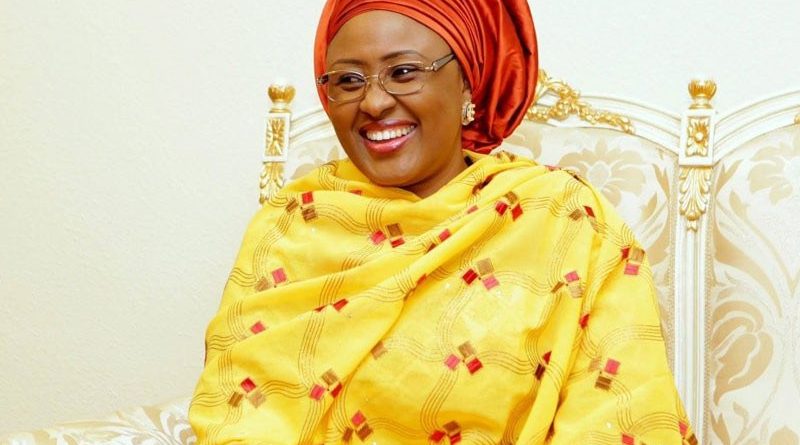FEATURED
Child Labour Threat To Children’s Development In Nigeria, Admits Aisha Buhari

Nigeria’s First Lady and wife of the President, Aisha Muhammadu Buhari has admitted that the menace of child labour still poses threats to development of children in Nigeria.
Aisha Buhari also noted that it was regrettable that the trend still persist, despite legislative measures taken by government at various levels to curb it.
The First Lady represented by the wife of the Kwara State Governor, Olufolake AbdulRazaq, made these observations on Tuesday, when she spoke at the National Children’s Conference in commemoration of the 2022 World Day Against Child Labour, which held at the Presidential Villa Abuja.
She however called for increased investment in social protection systems and schemes to establish solid social protection floors and protect children from child labour.
Director, ILO Country Office for Nigeria, Ghana, Liberia, Sierra Leone and Liason Officer for ECOWAS, Vanessa Phala lamented that about 1.5 billion children globally are calling out to stakeholders for intervention.
According to the ILO representative, 1.5 billion children worldwide, between the ages of 0-14, receive no family or child cash benefits and more than 160 million children are still engaged in child labour.
Quoting a recent statistics by the United Nations Children’s Fund (UNICEF), the 2020 Global Estimates of Child Labour, 160 million girls and boys will remain in child labour, with half of that number in hazardous work if steps are not taken to fully domesticate and implement the child rights Act.
“Most children engaged in child labour are found in Agricultural sector, approximately 112 million worldwide, there is evidence to show that the recruitment of child soldiers continues; and that from 2016-2020, child labour increased by 8.9 million, among children aged 5-11.
“Beyond the statistics, child labour is a real and present danger to everyone.
“In Nigeria, not less than 15 million children are engaged in child labour, and half of this number is bearing the heavy burden of hazardous work,” Phala noted in her remarks.
The ILO Director rallied stakeholders to build upon the commitments made in the context of the 2022 Durban Call to Action; the Oslo International Conference on Child Labour, 1997, which mobilized a worldwide
movement against child labour; including the Hague Global Child Labour Conference, 2010, resulting in a
practical roadmap for the Elimination of the Worst Forms of Child Labour.
She also harped on the need to embrace the III Global Conference
on Child Labour, Brasilia, 2013, which embedded efforts against child labour within a framework of fundamental labour rights; as well as the IV Global Conference on the Sustained Eradication of Child
Labour, Buenos Aires, 2017, where some one hundred pledges for action to eliminate child labour
and forced labour were made, resulting, in ratifications of ILO child labour conventions.
Minister of Labour and Employment, Chris Ngige who corroborated other speakers, noted at amidst growing concerns of a global social crisis, estimates have shown that child labour is on the rise; with an increase from 152 million to 160 million between 2016 and 2020.
He said in Sub-Saharan Africa 19.6 per cent of all African children are engaged in Child Labour, with an average of 9 per cent in hazardous work; which is in contrast to continued progress being made elsewhere in the world.
According to Ngige, Child Labour has become a scourge in Nigeria, adding that several children find themselves on the streets, forced to make a living, with others employed in industrial complexes, and hazardous environments.
“Statistics revealed there are about 15 million child workers as at 2020, according to the ILO, with the UN warning that the absence of mitigating strategies could see an increase of children engaged in Child Labour by the end of 2022. This of course, will most certainly have massive implications in the near future.
“However, as a country, we take pride in stating that considerable efforts have been made in dealing with this menace. Most notably the adoption and ratification of ILO Conventions 138 and 182 on Minimum Age and Worst forms of Child Labour respectively.
“The passage of the Child Rights Act into law to domesticate the Convention on the Rights of the Child, with adoption by about 30 state governments; the implementation and enforcement of National Action Plan on Child Labour, Prohibition and Elimination of Forced Labour, Modern Slavery, and Human Trafficking in workplaces spearheaded by the Federal Ministry of Labour and Employment.
“Also the National Steering Committee, as well as State Steering Committees, and Desk Officers on Child Labour were established at all levels of government and institutional levels to translate the provisions of the 5-year National Action Plan. In spite of all these, we require more collaboration and partnerships to confront the task ahead of us,”Ngige noted.
End
-
CRIME3 years ago
PSC Dismisses DCP Abba Kyari, To Be Prosecuted Over Alleged $1.1m Fraud
-
FEATURED3 years ago
2022 Will Brighten Possibility Of Osinbajo Presidency, Says TPP
-
FEATURED2 years ago
Buhari’s Ministers, CEOs Should Be Held Accountable Along With Emefiele, Says Timi Frank
-
BUSINESS & ECONOMY2 years ago
Oyedemi Reigns As 2023’s Real Estate Humanitarian Of The Year
-
SPORTS1 year ago
BREAKING: Jürgen Klopp Quits Liverpool As Manager At End Of Season
-
SPORTS2 years ago
Could Liverpool Afford Kylian Mbappe For €200 million? Wages, Transfer Fee
-
ENTERTAINMENT2 years ago
Veteran Nigerian Musician, Basil Akalonu Dies At 72
-
FEATURED2 years ago
Tribunal Judgement: Peter Obi Warns Of Vanishing Electoral Jurisprudence, Heads To Supreme Court
-
BUSINESS & ECONOMY2 years ago
Oyedemi Bags ‘Next Bulls Award’ As BusinessDay Celebrates Top 25 CEOs/ Business Leaders
-
FEATURED3 years ago
2023 Presidency: South East PDP Aspirants Unite, Demand Party Ticket For Zone



































